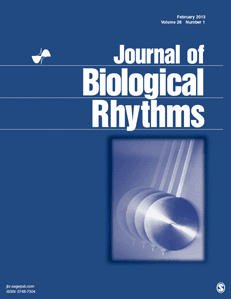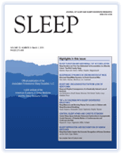
JOURNAL OF BIOLOGICAL RHYTHMS
Scope & Guideline
Illuminating Patterns: The Intersection of Health and Biological Rhythms
Introduction
Aims and Scopes
- Circadian Rhythms and Mechanisms:
The journal emphasizes research on circadian rhythms, exploring the molecular, genetic, and neural mechanisms that regulate these daily cycles in various organisms. - Impact of Environmental Factors:
A core area of focus is the influence of environmental factors, such as light and temperature, on biological rhythms and their adaptive significance. - Health and Disease Connections:
Research linking biological rhythms to health outcomes, including sleep disorders, metabolic syndromes, and the impact of circadian disruption on various diseases, is a significant theme. - Comparative and Evolutionary Studies:
The journal encourages comparative studies across species to understand evolutionary adaptations of biological clocks and rhythms. - Innovative Methodologies:
There is a consistent focus on advancing methodologies for studying biological rhythms, including wearable technology, genetic manipulation, and mathematical modeling.
Trending and Emerging
- Wearable Technology and Real-World Applications:
The use of wearable technology to monitor biological rhythms in real-world settings is on the rise, emphasizing practical applications of circadian science in health and wellness. - Chronobiology and Immunology:
Emerging research linking circadian rhythms with immune responses and vaccine efficacy is gaining traction, particularly in light of recent global health challenges. - Integration of Chronobiology with Psychosocial Factors:
There is an increasing focus on how biological rhythms intersect with psychosocial factors, including stress, mental health, and lifestyle choices. - Molecular and Genetic Insights:
Research exploring the molecular and genetic basis of circadian rhythms, including CRISPR and transcriptomic approaches, is becoming more prominent. - Environmental and Climate Influences:
Studies examining how environmental changes and climate factors affect biological rhythms are emerging, reflecting a growing awareness of ecological impacts on health.
Declining or Waning
- Traditional Chronobiology Models:
Research relying heavily on traditional models of circadian biology has decreased, as newer methodologies and integrative approaches gain prominence. - Effects of Specific Light Wavelengths:
Studies concentrating solely on the effects of specific light wavelengths on circadian rhythms are becoming less frequent, with broader environmental interactions taking precedence. - Simplistic Behavioral Observations:
There is a waning interest in simplistic behavioral observations without molecular or mechanistic insights, as the field moves toward more comprehensive analyses. - Static Analyses of Circadian Patterns:
Static analyses of circadian patterns are being replaced by dynamic and integrative studies that consider multiple interacting variables over time. - Focus on Individual Species:
Research that focuses exclusively on individual species without comparative or cross-species implications is becoming less common, as the field seeks to understand broader biological principles.
Similar Journals

JOURNAL OF SLEEP RESEARCH
Advancing Knowledge in Sleep and Neuroscience.JOURNAL OF SLEEP RESEARCH, published by Wiley, stands as a leading platform for disseminating innovative research and insights in the fields of sleep science, behavioral neuroscience, and cognitive neuroscience. With a commendable Impact Factor that reflects its pivotal role in advancing our understanding of sleep and associated neurological processes, this journal ranks in the top quartile (Q1) across multiple categories in 2023—demonstrating its substantial influence and outreach. The journal's dedicated focus spans various aspects of sleep research, from basic science to clinical applications, making it an invaluable resource for researchers, clinicians, and students alike. Operating from the United Kingdom, the journal has been in continuous circulation since 1992 and will continue to contribute to the field until at least 2024. For those seeking to enrich their knowledge and stay abreast of the latest advancements in sleep research, the JOURNAL OF SLEEP RESEARCH is an essential read.

Physiological Reports
Connecting Researchers to a World of Physiological DiscoveriesPhysiological Reports is a pioneering open-access journal published by WILEY, dedicated to advancing the field of physiology through the dissemination of high-quality research. Since its inception in 2013, this journal has provided a platform for innovative studies in both general physiology and medical physiology, making significant contributions to our understanding of biological processes. With an impact factor that reflects its growing influence—as evidenced by its placement in the Q2 category for physiology and medical physiology in 2023—Physiological Reports is positioned as a vital resource for researchers and practitioners alike. The journal encourages the submission of diverse studies ranging from cellular mechanisms to systemic physiology, presenting a unique opportunity for authors to reach a global audience without access barriers. It has established a reputation for rigorous peer review and timely publication, ensuring that cutting-edge research is readily available to stimulate further inquiry and collaboration in the scientific community.

JOURNAL OF EVOLUTIONARY BIOCHEMISTRY AND PHYSIOLOGY
Illuminating Evolutionary Adaptations Through Biochemical ResearchJOURNAL OF EVOLUTIONARY BIOCHEMISTRY AND PHYSIOLOGY, published by PLEIADES PUBLISHING INC, is a pivotal periodical that delves into the intricate relationships between biochemical processes and evolutionary dynamics. With its ISSN 0022-0930 and E-ISSN 1608-3202, this journal serves as a comprehensive platform for researchers, professionals, and students dedicated to understanding the physiological adaptations and biochemical mechanisms influenced by evolutionary pressures. Although it is not an open access journal, it offers valuable insights across its historically significant coverage spanning from 1972 to 2017, making it an essential resource for those working in agricultural, biological, and molecular sciences. Despite its current Scopus rankings revealing limited visibility within its fields, the journal remains committed to fostering scholarly dialogue and advancing knowledge in the realm of evolutionary biochemistry, especially for those exploring the ecological, genetic, and integrative physiological aspects of life.

Physiological Genomics
Decoding the Genetic Blueprint of Physiological ProcessesPhysiological Genomics is a prestigious scholarly journal published by the American Physiological Society, dedicated to advancing the understanding of the genetic underpinnings in physiology. With an ISSN of 1094-8341 and an E-ISSN of 1531-2267, this journal serves as a vital platform for researchers exploring the intersection of genetics and physiological processes. As of 2023, it enjoys a respectable impact factor, particularly standing strong in the Q2 quartile in both Genetics and Physiology categories, illustrating its importance within a competitive landscape. With an impressive rank of #69 out of 193 in Biochemistry, Genetics, and Molecular Biology - Physiology, and #128 out of 347 in Genetics, it reflects a robust commitment to quality research. Committed to fostering innovation, Physiological Genomics provides comprehensive access to groundbreaking studies from 1999 to 2024 and remains a quintessential resource for researchers, professionals, and students alike aiming to enhance their understanding of physiological genomics.

COMPARATIVE BIOCHEMISTRY AND PHYSIOLOGY A-MOLECULAR & INTEGRATIVE PHYSIOLOGY
Integrating Knowledge Across Biochemistry and Physiology.Comparative Biochemistry and Physiology A-Molecular & Integrative Physiology, published by Elsevier Science Inc, serves as a pivotal platform for cutting-edge research in the fields of biochemistry, physiology, and animal sciences. The journal, holding an esteemed presence with an ISSN of 1095-6433 and E-ISSN 1531-4332, spans a remarkable history of contributions since its inception in 1960, showcasing significant findings up to 2024. As a Q1 quartile journal in Animal Science and Zoology and featuring competitive rankings across various biochemistry and physiology disciplines, it stands out as a leading resource for both established researchers and emerging scholars alike. The journal is committed to publishing high-quality, peer-reviewed articles that deepen our understanding of molecular and integrative physiology, playing an essential role in advancing scientific knowledge and fostering interdisciplinary collaboration. With access options that prioritize the dissemination of impactful research, Comparative Biochemistry and Physiology continues to shape the dialogue within these dynamic fields.

Eneurobiologia
Empowering Global Access to Neurobiological InsightsEneurobiologia is an esteemed open-access journal published by UNIV VERACRUZANA, INST INVESTIGACIONES & EDUCACION, dedicated to advancing research in the vibrant field of neurobiology. With its launch in 2010, the journal aims to disseminate high-quality, peer-reviewed research articles that explore the complexities of neural systems, neurodevelopment, and neurodegenerative disorders. By providing a platform for both established researchers and emerging scholars, Eneurobiologia fosters interdisciplinary collaboration and knowledge exchange within the scientific community. Its open-access model ensures that valuable findings are accessible to a global audience, promoting the widespread application of neurobiological research. As a crucial resource for students, professionals, and researchers alike, Eneurobiologia plays a pivotal role in shaping the future of neurobiological studies and enhancing our understanding of the brain and nervous system.

GENETICS AND MOLECULAR BIOLOGY
Unveiling discoveries in genetics and molecular biology.GENETICS AND MOLECULAR BIOLOGY, published by the SOC BRASIL GENETICA, is a prominent journal dedicated to the advancement of knowledge in the fields of genetics and molecular biology. Since its inception in 1998, this Open Access journal has served as a vital platform for researchers, professionals, and students to disseminate their findings and engage with the latest innovations and discoveries. With an impact factor that reflects its growing influence, GENETICS AND MOLECULAR BIOLOGY ranks in the Q3 category for both genetics and molecular biology as of 2023, indicating its position within the academic community. The journal is indexed in Scopus, highlighting its commitment to maintaining rigorous peer-review standards while providing wide-reaching access to quality research. Operating out of Ribeirão Preto, Brazil, it fosters a collaborative environment for academic discourse and research development not only in Brazil but also globally. The journal encourages submissions that explore a wide range of topics in genetics and molecular biology, making it an essential resource for anyone involved in these dynamic fields.

Molecular Metabolism
Illuminating the Molecular Mechanisms of MetabolismMolecular Metabolism is a premier, open-access journal published by Elsevier, dedicated to advancing the understanding of metabolic processes at the molecular level. With an ISSN of 2212-8778 and a proud presence in Germany, the journal has made significant contributions to the fields of Cell Biology and Molecular Biology, consistently achieving a Q1 ranking in both categories as of 2023. The journal’s scope encompasses cutting-edge research that explores metabolic pathways, their regulation, and implications for human health, underscoring the interplay between metabolism and various biological functions. Researchers and professionals benefit from the journal’s robust visibility, as it ranks #40 among 410 journals in Molecular Biology and #35 among 285 in Cell Biology according to Scopus metrics, placing it in the top 10 percentile in its field. With open access since 2012, Molecular Metabolism ensures that groundbreaking research is available to all, fostering a collaborative and inclusive academic environment. Its commitment to excellence and accessibility makes it an invaluable resource for those invested in metabolic research.

Nature and Science of Sleep
Bridging Research and Practice in Sleep ScienceNature and Science of Sleep is an esteemed open-access journal published by Dove Medical Press Ltd, dedicated to the interdisciplinary fields of sleep science and behavioral neuroscience. Since its inception in 2009, the journal has become a vital resource for researchers, clinicians, and students alike, offering a platform for innovative research and insights that advance the understanding of sleep and its profound effects on human health and behavior. With a commendable Q2 ranking in both Applied Psychology and Behavioral Neuroscience as of 2023, it positions itself in the top tier of its fields, reflecting its importance and relevance in ongoing discussions and research. Accessible globally, Nature and Science of Sleep serves to bridge the gap between basic research and practical applications, facilitating the dissemination of knowledge that informs better practices in sleep medicine, psychology, and neuroscience. With an active commitment to fostering scientific dialogue, the journal continues to influence best practices and set new standards in sleep research through its rigorous peer-review process and focus on high-impact studies.

SLEEP
Illuminating the Path to Better Sleep HealthSLEEP is a premier academic journal published by Oxford University Press, renowned for its high-impact contributions to the fields of neurology and physiology. Since its inception in 1978, this journal has been dedicated to advancing the understanding of sleep, its disorders, and its various physiological implications. With an impressive impact factor, SLEEP occupies a distinguished Q1 ranking in both clinical neurology and medical physiology, illustrating its pivotal role in the dissemination of cutting-edge research. The journal is recognized for its rigorous peer-review process and has achieved remarkable rankings in Scopus, placing it among the top-tier journals in its category. Researchers, healthcare professionals, and students in the sleep sciences will find in SLEEP a valuable resource that not only reflects the latest scientific advancements but also contributes to the ongoing dialogue regarding sleep's critical influence on health and well-being.